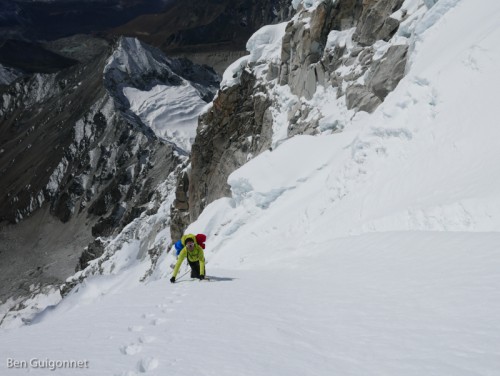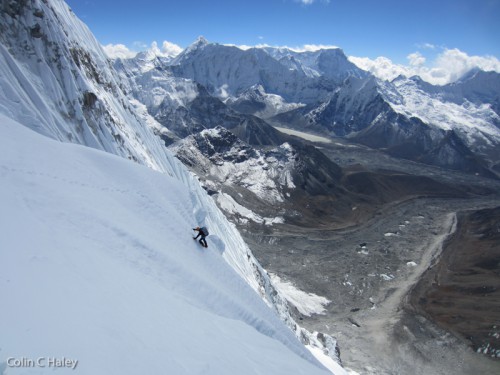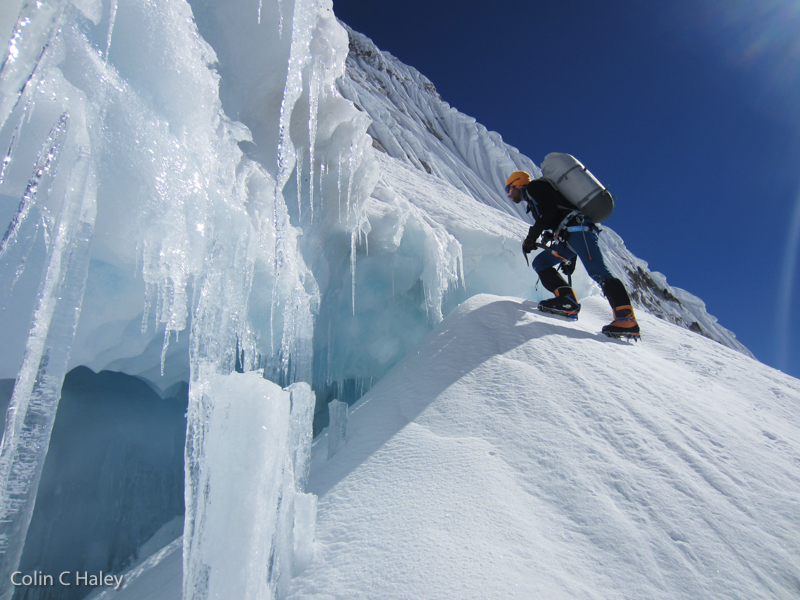I’ve just recently returned to the US from my second trip to the Nepalese Himalaya. In late September I met up with Ueli Steck in Kathmandu, and the next day we flew to the Khumbu region. Our plan was an alpine-style attempt on the southeast buttress of Nuptse East, the line named “Moonlight Sonata” by its first ascensionists, Valeri Babanov and Yuri Koshelenko. In addition to Nuptse, we had procured permits for Lobuche East and Cholatse, for nice acclimatization options.
A few days of trekking brought us to the village of Dzongla (4,800m), our “basecamp” for the first portion of our trip. They say that one’s body “learns” to acclimatize more efficiently the more times it’s been put through that process, and clearly Ueli’s past decade of roughly two Himalayan trips per year has had that effect. He is able to acclimatize extremely quickly, and I realized on this trip that while he is very fit in general, his “fitness percentile” (fitness compared to others) is even higher at high altitudes. This caused some tension early in the trip, as the weather was very good and Ueli was eager to acclimatize and get climbing as fast as possible. At Ueli’s urging I tried to keep up, and we spent our first night sleeping at 6,000m (on the summit ridge of Lobuche East) on only day 5. Unfortunately, this acclimatization schedule simply wasn’t realistic for my body, and pushing too hard resulted in a compromised immune system and subsequent cold.
I spent a few nights down at the village of Debuche (3,600m) to get over my cold, while Ueli did some more acclimatization on Lobuche East. The Khumbu region can hardly be considered expedition climbing, with lodges, internet and cell service nearly everywhere, but this infrastructure sure is convenient, and makes it particularly easy to vary the altitude at which you’re sleeping at any time. When I came back up to Dzongla, Ueli felt fully acclimatized and was eager to use some of the excellent weather. Unfortunately, I simply wasn’t well enough acclimatized yet to take advantage of it. While I headed back up on Lobuche East for a couple more nights of acclimatization, Ueli climbed the north face of Cholatse (for his third time!) with our “guide” Tenji Sherpa. The Nepalese government requires expeditions to hire a guide, which we didn’t actually need, but fortunately Tenji is a friend of Ueli’s since several years ago. They climbed Chomolungma (AKA Everest) together, as normal climbing partners (no money exchanged), in 2012 without supplemental oxygen. Unlike many Sherpas who are interested in climbing mountains only for business, Tenji is young, fit, motivated and passionate about climbing mountains. His was the first Nepalese ascent of the north face of Cholatse, which is pretty cool. I was of course bummed to miss out on the climb, but I understand as well as anyone the importance of using good weather when you can. Unfortunately, that was pretty much the end of the good weather…
Up on Lobuche East for my second time, I felt good and slept well at 6,000m. Unfortunately, when I came back down to Dzongla, the weather forecast had changed drastically, and Ueli and I decided to hike down-valley for a couple nights and wait out the storm at lower elevation. After a couple nights down low in Namche Bazaar, we felt restless and hiked back up valley. This time we turned east and hiked to the village of Chukkung (4,700m), underneath our main objective: Nuptse (7,800m). On our way back up valley we met up with Hélias Millerioux and Ben Guigonnet, the two young French climbers that we had arranged with beforehand to share the Nuptse south face permit cost.
While we were down in Namche Bazaar it had snowed a fair amount, and for our first week in Chukkung it snowed every afternoon. The accumulation was never massive on any single day, but over the course of the week it added up to a fair amount of new snow. Unfortunately this was often accompanied by wind, and therefore dangerous avalanche hazard. Nonetheless, I managed to get out for a couple additional acclimatization days with Hélias and Ben up to 6,000m.
While the snow piled up on the slopes of Nuptse, the day and nighttime temperatures began to drop, and the weather forecast began to call for consistent high winds above 7,000m. Ueli had already been forewarning for weeks about the potential problem of building wind. With the colder temperatures we realized we’d have to carry a lot of extra clothing and warmer sleeping bags to have a chance of staying warm enough up high. Between this additional weight, the high winds and all the new snow, we began to think that the southeast buttress would not be a realistic objective. Ben and Hélias, who had been hoping to attempt a similarly-difficult line on the “Cobweb Wall” (the western portion of the south face), had similar thoughts, and we decided all together to pin our hopes on the line of least resistance on Nuptse’s south face – basically the British-Nepali route (AKA Bonington route), but with a more direct start to the right of the original start.
A couple times we packed our bags for an attempt only to cancel due to the deteriorating weather forecast. It was a continually difficult decision whether to try or not, because the weather forecast indicated that the winds at high altitude were too strong, but below 6,000m it seemed pretty pleasant. Finally, early on the morning of Oct. 23, the four of us left Chukkung for an attempt. We were well aware that the amount of fresh snow was probably a problem, and we were well aware that the winds were likely too high above 7,000m. However, the weather forecast indicated that the slightly lesser winds on the 23rd and 24th would be our only shot whatsoever.
We started up the face at about 7am, on a line previously attempted by Jordi Tozas. The terrain was mostly easy 40-to-60-degree slopes of snow and nevé, with an occasional step of AI3. We were all happy to finally be having a go, and simul-soloed along. Ueli, living up to his “Swiss Machine” nickname, did all of the trailbreaking, as none of us were fast enough to keep pace with him otherwise. I was impressed! At roughly 6,300m we joined up with the British-Nepali route. We made our bivouac on a subtle ridge at 6,900m. We had made pretty good time, arriving here by about 2pm, but it had already started snowing about an hour earlier.
Throughout the afternoon, evening and night it snowed. At first we kept our hopes up, but then during the night it got windier and windier. By the time our alarm went off at 4:30am it was clear that we were going down, not up. We packed up our bivy at first light and headed down, wearing all of our clothing and ski goggles. When we left the crest of the ridge onto the leeward and sunny side (leaving the British-Nepali route to descend the line of the Tozas attempt), it became much warmer, but there was an alarming amount of snow that had accumulated overnight. Some slopes on the descent were waist-deep, and much more dangerous than I would’ve liked. The next day we double-checked the weather forecasts to make sure there was no hope in sight, and then began the journey home.
I would’ve of course loved to have climbed Nuptse (and Cholatse for that matter), but failure is part of the alpine climbing game. I’m happy to at least have gone to a higher altitude than I’d been before (6,900m), and felt pretty good for a 16-hour stint there, which gives me confidence for the future on other 7,000m summits.
I owe many thanks to the Mugs Stump Award, which helped me afford this trip. Without it I definitely would not have been able to go and try.














































